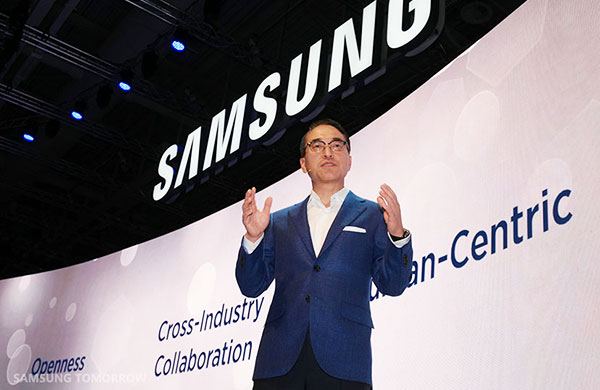Samsung last week plunged into the Internet of Things for the home market, unveiling a new hub to control connected gadgets, home and sleep monitors, and a smart washing machine. The company made the announcements at IFA 2015, a large European trade show for consumer electronics and home appliances.
The SmartThings Hub for home devices is based on technology Samsung acquired a year ago when it purchased SmartThings. It is built around a powerful processor that enables video monitoring, and it includes a battery backup that lasts up to 10 hours in case of a power outage. The unit’s video-monitoring capability allows people to access a live stream at any time, yet only records video when an unexpected event, such as motion by the front door, is detected.
“Putting a processor in the hub, so all the devices aren’t required to be connected to the cloud at all times, is an absolutely essential piece of this,” said Bill Morelli, director of IoT, M2M and connectivity at IHS.
“It can transmit to the cloud as needed, but it doesn’t require a connection to the cloud to function,” he told TechNewsWorld.
That’s important, because “if you have 25 to 50 devices sending data to the cloud on a continual basis, that’s a ridiculous waste of bandwidth,” Morelli continued. “Some of that data can be processed at the hub, and only important data sent to the cloud and the owner notified of it.”
Watches While You Sleep
Samsung also announced its Smart Home Monitor. The device provides unified access and control against intrusion, and reacts to smoke, fire, leaks, floods, and other common household issues by delivering real-time notifications and video clips from multiple cameras via the SmartThings mobile app.
Another Samsung monitor watches over you while you sleep. SleepSense is a flat disk that can be popped under a mattress for the purpose of monitoring your heart and respiratory rate, as well as movements during sleep, without having to touch you.
What’s more, it can “talk” to other devices, so when you go to sleep, it can turn off the television, and adjust the heating or air conditioning automatically for a perfect sleep environment.
Samsung also pulled the wraps off its AddWash washing machine. Associated Android and iOS apps let you remotely monitor and operate the machine, as well as receive a range of notifications straight to your smartphone.
New Openness?
Samsung’s IoT strategy is rooted in openness and cross-industry collaboration, and it’s centered on human usage, the company said.
That hasn’t always been the case in the past, noted Ross Rubin, principal analyst with Reticle Research.
“SmartThing, before being acquired by Samsung, took a very open approach, trying to accommodate many different standards without playing favorites,” he told TechNewsWorld. “That’s in contrast to Samsung, which has come out in favor of some IoT standards and not others.”
Openess hasn’t been one of Samsung’s strong suits, observed Patrick Moorhead, principal analyst at Moor Insights and Strategy.
“Like Apple, Samsung has historically operated in a very insular fashion, as they can make nearly all their components and end products,” he told TechNewsWorld. “I would like to see Samsung support all the IoT standards — like AllSeen, OIC, Apple HomeKit, and Google Brillo and Nest. Now that would be open and awesome.”
More Than Me-Too
While Samsung’s new products give the brand an IoT presence in the home, whether they can distinguish themselves from competitors in the market remains to be seen.
“Samsung’s push into the IoT space is intriguing, but the new solutions the company introduced have — at least on the surface — many similarities with other vendors’ offerings,” said Charles King, principal analyst at Pund-IT.
“That may simply reflect the nature of the consumer IoT market, which focuses largely on commonplace events, processes and home appliances,” he told TechNewsWorld.
If Samsung wants to succeed in the IoT home market, it needs to deliver on its human-centric product pledge, suggested Greg Sterling, vice president of strategy and insight at the Local Search Association.
“The issue is whether Samsung can actually deliver products that live up to the hype,” he told TechNewsWorld.
“Their smartwatches, for example, have been inelegant and generally offered a poor user experience,” Sterling said, “but the fact that there are so many Samsung TVs, computers and smartphones in the world gives them a headstart regarding consumer awareness and brand loyalty.”
Costly Pastime
Even if Samsung delivers on its promises, uncertainties are still swirling around the IoT home market.
“You have to have a strong value proposition for consumers to do this,” said Jim McGregor, principal analyst at Tirias Research. “Some of these smart light switches run (US)$30. How many consumers want to spend $30 on a light switch?”
IoT easily can become an expensive pastime for consumers, said Bob O’Donnell, chief analyst at Technalysis Research.
“If someone bought all the things supported by SmartThings, it would cost thousands of dollars,” he told TechNewsWorld. “SmartThings is a good product, but the category is really lacking. Even Apple hasn’t been able to do anything in it.”
Security is also a problem within the category.
“With all these things, you want security built-in from the beginning,” said Ciaran Bradley, chief product officer with AdaptiveMobile.
“Unfortunately,with some of the devices we’re seeing, security is an afterthought,” he told TechNewsWorld.
Perhaps calling it an “afterthought” was putting it too nicely.
When it comes to security, “most of the IoT solutions out there suck,” Tirias’ McGregor told TechNewsWorld. “When I ask these companies how they’re protecting the data they’re streaming, none of them have an answer.”





















































